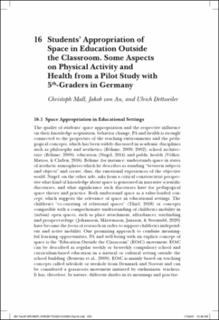| dc.description.abstract | In this article, we explore pupils’ appropriation of space in educational settings that take place outside the classroom. We first introduce the much-neglected concepts of place and space in educational contexts. Hereby, space expresses the abstract conception of geographical locations, which are then socio-culturally constructed as meaningful places.
We argue that places are very much qualified by atmospheres where the emotional experiences of the “objective” world are created within the subjects. Space on the other hand is the condition in which meaning is created in narrative discourses and where concrete pedagogical practice evolves. Hereby, pupils co-curate relational space by means of their mobility customs in (urban) open spaces. We then introduce education outside the classroom (EOtC) as a school form that facilitates and fosters the pupils’ space appropriation and offer finally some empirical insights from a case study in a German school. We show that EOtC increases not only the pupils’ physical activity (PA) levels during class but also their ability to better concentrate in relation to the learning environment. Many students use the physical freedom that comes with open learning spaces to interact with students that they rarely meet in closed classroom situations and to satisfy their need of movement during complicated understanding processes.
In education, space has been of interest since its earliest days, both physical and metaphorical (Oelkers, 1993, p. 634). However, after a long period of “space neglection” at the end of the 20th century, new interest in educational spaces has recently increased, at least at many German schools (Berndt, Kalisch, & Krüger, 2016). From an educational perspective, Students’ space appropriation, i.e. the different strategies to deal and bodily interact with the teaching environment, can be understood as an inherent process in every teaching situation. Hereby, space expresses the abstract conception of geographical locations or socio-culturally constructed and meaningful places.
This chapter will discuss the idea of space appropriation in educational settings, link it to an overview over research findings in Education Outside the Classroom and present evidence from a pilot study conducted in Heidelberg. Finally, future research directions will be discussed. | en_US |
